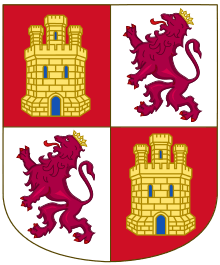Canting arms
Canting arms are heraldic bearings that represent the bearer's name (or, less often, some attribute or function) in a visual pun or rebus. The term was derived from the Anglo-Norman cant, meaning song or singing.
French heralds used the term armes parlantes (English: "talking arms"), as they would sound out the name of the armiger. Many armorial allusions require research for elucidation because of changes in language and dialect that have occurred over the past millennium.
Canting arms – some in the form of rebuses – are quite common in German civic heraldry. They have also been increasingly used in the 20th century among the British royal family. When the visual representation is not straightforward but as complex as a rebus, this is sometimes called a rebus coat of arms. An in-joke among the Society for Creative Anachronism heralds is the pun, "Heralds don't pun; they cant."[2] That lends itself to the perhaps more vulgar jibe that heraldic arms are sometimes taken up in fun, though to bear them is not always a mark of cant. A few families have genuinely had armorial crests for centuries traceable back through numerous generations to feudal social relations of the European Middle Ages. Others, however, began to sport them many long years after the first establishment of the College of Arms, and may be regarded, at least by some socially superior snobs, as parvenus. For such indicia are sometimes taken to convey, or at least to imply a claim to, social distinction. However, all such arms were once newly created.
Examples of canting arms
Personal coat of arms
A famous example of canting arms is those of Queen Elizabeth the Queen Mother (consort of King George VI of the United Kingdom). Her arms (pictured below) contain in sinister (i.e. on the bearer's left, viewer's right) the bows and blue lions that make up the arms of the Bowes and Lyon families.
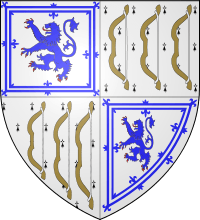 Bowes-Lyon family: bows and lions
Bowes-Lyon family: bows and lions Princess Beatrice of York: Beatrice = bee thrice = three bees
Princess Beatrice of York: Beatrice = bee thrice = three bees.svg.png) Rosetti family: three roses
Rosetti family: three roses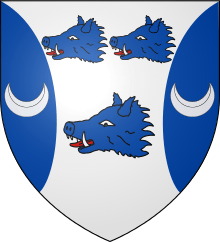 Quintin Hogg, Baron Hailsham of St Marylebone: three hog's heads
Quintin Hogg, Baron Hailsham of St Marylebone: three hog's heads
 Crowninshield family: crown on the shield
Crowninshield family: crown on the shield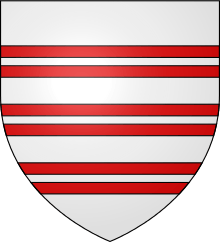 De Barry family: three bars gemelles
De Barry family: three bars gemelles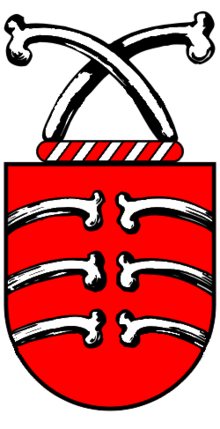 Coat of arms of the head of the Portuguese Costa family: costa means "rib" in Latin
Coat of arms of the head of the Portuguese Costa family: costa means "rib" in Latin
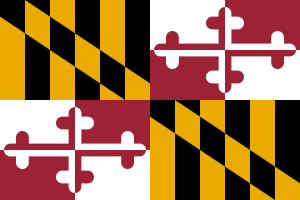 Flag of Maryland, originally the arms of George Calvert, 1st Lord Baltimore, whose mother's maiden name was Crossland; the latter's arms shows a cross.[3]
Flag of Maryland, originally the arms of George Calvert, 1st Lord Baltimore, whose mother's maiden name was Crossland; the latter's arms shows a cross.[3]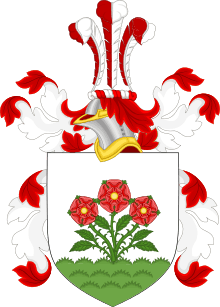 Theodore Roosevelt: roses-fields
Theodore Roosevelt: roses-fields.svg.png) Van Dievoet family: Voet means "foot" in Dutch; the inescutcheon on the tower shows a foot sole.
Van Dievoet family: Voet means "foot" in Dutch; the inescutcheon on the tower shows a foot sole.
Municipal coat of arms
Municipal coats of arms which interpret the town's name in rebus form are also called canting. Here are a few examples.
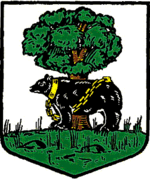 The arms of Berwickshire, Scotland: Bear and Wych Elm
The arms of Berwickshire, Scotland: Bear and Wych Elm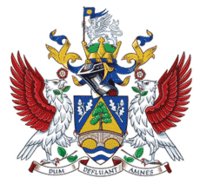 Elmbridge, Surrey (1974): elm tree on bridge. (The toponym is related to bridges but not to elms; the prefix refers to Emel, a former name for the river Mole.[4])
Elmbridge, Surrey (1974): elm tree on bridge. (The toponym is related to bridges but not to elms; the prefix refers to Emel, a former name for the river Mole.[4]).svg.png) Châteaurenard: Château = castle; Renard = fox
Châteaurenard: Château = castle; Renard = fox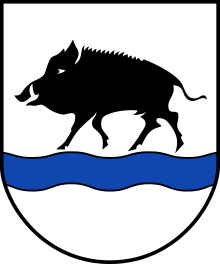 Eberbach (1976): Eber = boar; Bach = brook (wavy blue fess)
Eberbach (1976): Eber = boar; Bach = brook (wavy blue fess) of the village of Hensbroek in North Holland interprets the toponym as "hen-breeches" (the toponym is unrelated to either "hen" or "breeches", deriving from a personal name Hein and the Dutch cognate of "brook", i.e. "Henry's brook".)
of the village of Hensbroek in North Holland interprets the toponym as "hen-breeches" (the toponym is unrelated to either "hen" or "breeches", deriving from a personal name Hein and the Dutch cognate of "brook", i.e. "Henry's brook".) Freixo de Espada à Cinta (1926): Freixo = ash; de Espada = with sword; à Cinta = at the waist, in Portuguese
Freixo de Espada à Cinta (1926): Freixo = ash; de Espada = with sword; à Cinta = at the waist, in Portuguese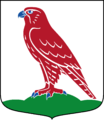 Falkenberg (1948): Falken = falcon; Berg = hill, in Swedish
Falkenberg (1948): Falken = falcon; Berg = hill, in Swedish
 Berlin (1954): Bär = bear
Berlin (1954): Bär = bear.svg.png)
.svg.png) Torrevieja (1829): Torre = tower, vieja = old
Torrevieja (1829): Torre = tower, vieja = old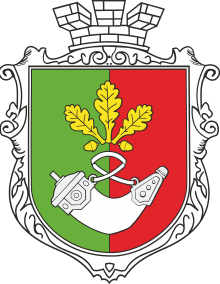 Kryvyi Rih: Kryvyi = crooked, Rih = horn, in Ukrainian
Kryvyi Rih: Kryvyi = crooked, Rih = horn, in Ukrainian.svg.png)
 Łódź: Łódź = boat
Łódź: Łódź = boat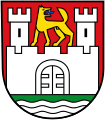 Wolfsburg: Wolf's Castle
Wolfsburg: Wolf's Castle.svg.png)
 Örnsköldsvik (1894): Örn = Eagle, Sköld = Shield and Vik = Bay.
Örnsköldsvik (1894): Örn = Eagle, Sköld = Shield and Vik = Bay. Füssen: Füssen = feet
Füssen: Füssen = feet
Ecclesiastical coats of arms
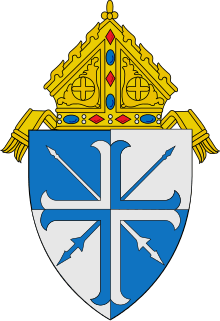 The arms of the Roman Catholic Diocese of Lansing: The lances crossed per saltire are a play on the name of the see, the city of Lansing, Michigan.[6]
The arms of the Roman Catholic Diocese of Lansing: The lances crossed per saltire are a play on the name of the see, the city of Lansing, Michigan.[6]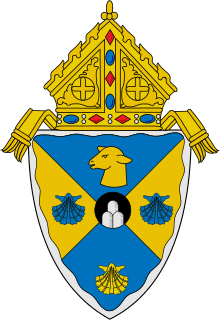 The arms of the Roman Catholic Diocese of Rockville Centre: The mounds in the circle at the center of the arms are a play on the name of city in which the diocese is based, Rockville Centre, New York.[7]
The arms of the Roman Catholic Diocese of Rockville Centre: The mounds in the circle at the center of the arms are a play on the name of city in which the diocese is based, Rockville Centre, New York.[7] The arms of the Roman Catholic Diocese of Baton Rouge: The shield features a red baton, referencing the city name, Baton Rouge, Louisiana, and its literal French meaning.
The arms of the Roman Catholic Diocese of Baton Rouge: The shield features a red baton, referencing the city name, Baton Rouge, Louisiana, and its literal French meaning. The arms of the Roman Catholic Diocese of Buffalo: The arms feature an American bison, colloquially called a buffalo, carrying a banner of the Cross of St. George (analogous to the heraldic Lamb of God), referencing the name of city in which the see is based, Buffalo, New York.
The arms of the Roman Catholic Diocese of Buffalo: The arms feature an American bison, colloquially called a buffalo, carrying a banner of the Cross of St. George (analogous to the heraldic Lamb of God), referencing the name of city in which the see is based, Buffalo, New York.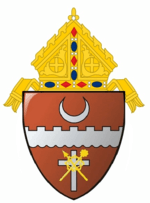 The arms of the Roman Catholic Diocese of Brownsville: The tincture of the field, tenné, is depicted as brown, referencing the seat of the diocese, Brownsville, Texas.
The arms of the Roman Catholic Diocese of Brownsville: The tincture of the field, tenné, is depicted as brown, referencing the seat of the diocese, Brownsville, Texas.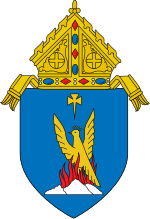 The arms of the Roman Catholic Diocese of Phoenix: The arms feature a phoenix, the namesake of the diocesan seat, Phoenix, Arizona.
The arms of the Roman Catholic Diocese of Phoenix: The arms feature a phoenix, the namesake of the diocesan seat, Phoenix, Arizona. The arms of the Roman Catholic Diocese of Fort Worth: The arms feature a castle, referencing the fort for which the city, Fort Worth, Texas, was named.
The arms of the Roman Catholic Diocese of Fort Worth: The arms feature a castle, referencing the fort for which the city, Fort Worth, Texas, was named. The arms of the Roman Catholic Archdiocese of Anchorage: The anchor references the namesake of the see, Anchorage, Alaska.
The arms of the Roman Catholic Archdiocese of Anchorage: The anchor references the namesake of the see, Anchorage, Alaska.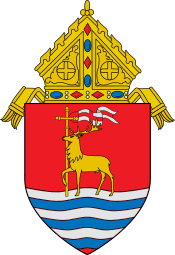 The arms of the Roman Catholic Archdiocese of Hartford: The arms feature a hart, a male deer, in the midst of flowing water, i.e., fording a body of water, referencing the name of the see, Hartford, Connecticut.
The arms of the Roman Catholic Archdiocese of Hartford: The arms feature a hart, a male deer, in the midst of flowing water, i.e., fording a body of water, referencing the name of the see, Hartford, Connecticut.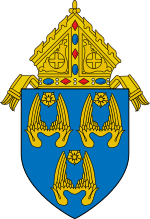 The arms of the Roman Catholic Archdiocese of Los Angeles: The arms feature three pairs of wings, denoting three angels, and referencing the namesake of the see, Los Angeles, California, which translates to "the angels."
The arms of the Roman Catholic Archdiocese of Los Angeles: The arms feature three pairs of wings, denoting three angels, and referencing the namesake of the see, Los Angeles, California, which translates to "the angels."
Notes
- "Tinctures".
- Neznanich, Modar. "Heraldry for Those Who Cant" (PDF). Retrieved 2 July 2012. Cites 72 historical examples of canting arms, as well as SCA usage.
- Englefield, Eric (1979). Flags. Ward Lock. p. 104.
- Room, Adrian (1988). Dictionary Of Place Names In The British Isles. Bloomsbury. p. 128.
- Schneider, Klaus-Michael. "Municipality of Manacor". Flags of the World. CRW Flags. Retrieved 16 October 2013.
- "Bishop Boyea arms". Diocese of Lansing. Roman Catholic Diocese of Lansing. Retrieved 9 May 2017.
- "Bishop Barres arms". Diocese of Rockville Centre. Roman Catholic Diocese of Rockville Centre. Retrieved 26 July 2018.
| Wikimedia Commons has media related to Canting arms. |
References
- "Meaning of Arms". Heraldica.org. 2001-06-20.
